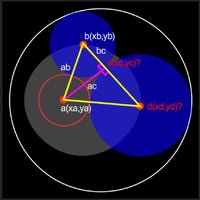DenisKurek
New member
- Joined
- Nov 11, 2019
- Messages
- 1
Hi,
It's probably gonna be a pretty simple thing to solve for you but I'm not that good in math so I'm really thankful for any help that you can bring me.
Long story short (refer picture below):
As you can see we have two circles forming two right angled triangles with a third one. The information in white are the ones I know and the ones in the red are the ones I'm looking for. So given the coordinates a and b, and the lengths ab, bc and ac, is it possible to find the coordinates of the point c in the right angled triangle abc.
Then, if it's possible to have the coordinate of c, is it possible to find the coordinate of the point d with the information we have?

It's probably gonna be a pretty simple thing to solve for you but I'm not that good in math so I'm really thankful for any help that you can bring me.
Long story short (refer picture below):
As you can see we have two circles forming two right angled triangles with a third one. The information in white are the ones I know and the ones in the red are the ones I'm looking for. So given the coordinates a and b, and the lengths ab, bc and ac, is it possible to find the coordinates of the point c in the right angled triangle abc.
Then, if it's possible to have the coordinate of c, is it possible to find the coordinate of the point d with the information we have?

